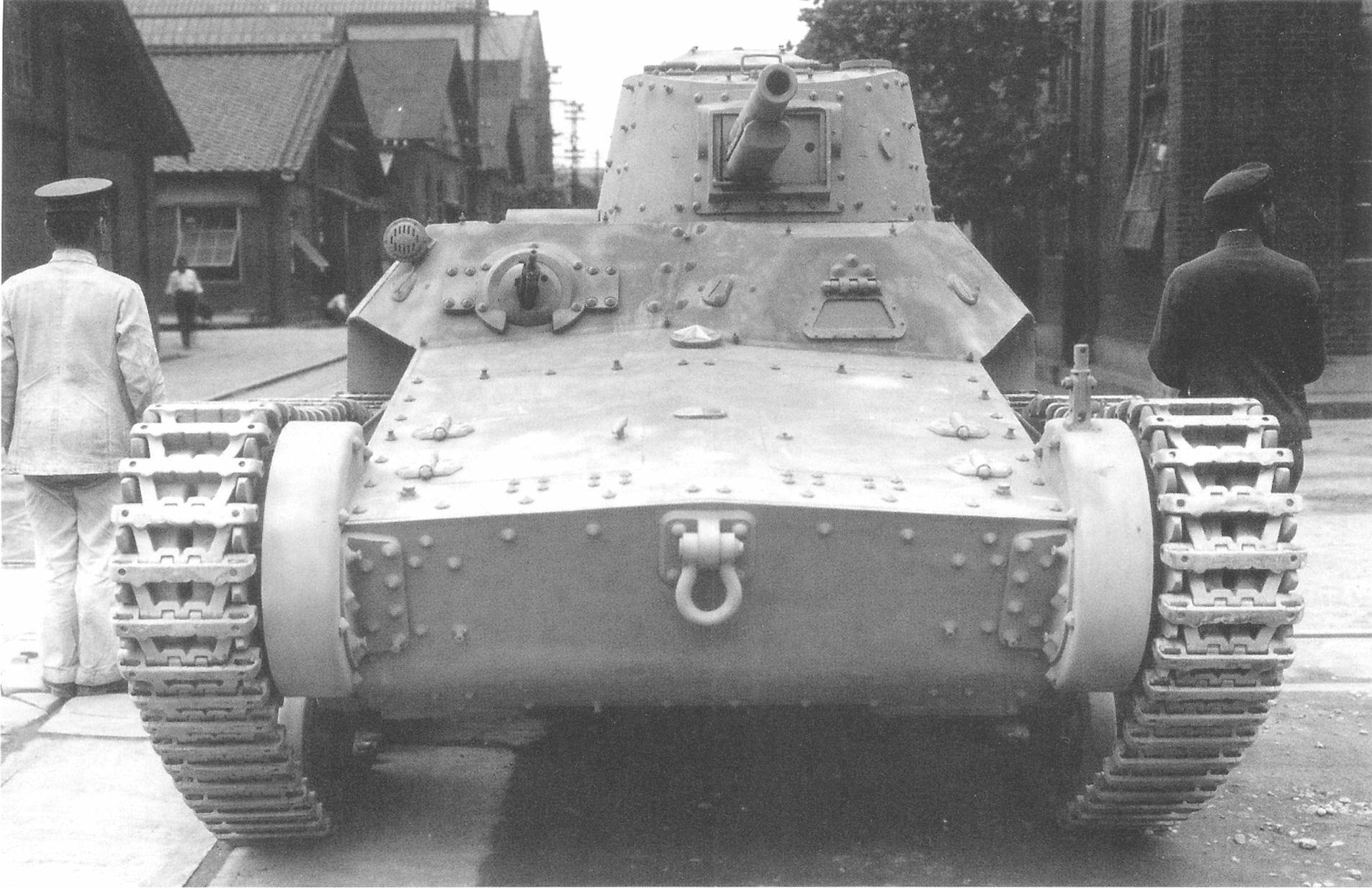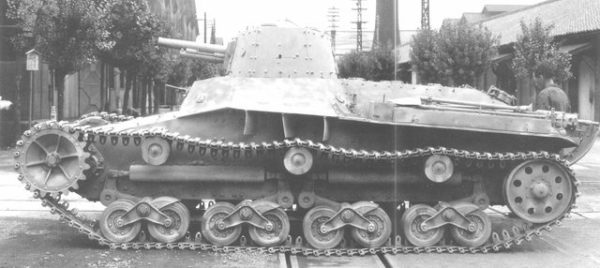Type 97 Chi-Ni on:
[Wikipedia]
[Google]
[Amazon]
The Experimental Medium Tank Chi-Ni (試製中戦車 チニ ''Shisei-chū-sensha chini'') was a prototype
 The initial design requirements for the two prototypes were:
The initial design requirements for the two prototypes were:
 The Chi-Ni was envisioned as a smaller, lighter alternative to the Chi-Ha, a medium tank closer to the original Chief-of-Staff Operations preference for more "lightly armored infantry support vehicles". The hull was of a
The Chi-Ni was envisioned as a smaller, lighter alternative to the Chi-Ha, a medium tank closer to the original Chief-of-Staff Operations preference for more "lightly armored infantry support vehicles". The hull was of a
 During the time of the Chi-Ni and Chi-Ha trials, the
During the time of the Chi-Ni and Chi-Ha trials, the
Taki's Imperial Japanese Army Page: "THE DEVELOPMENT OF IMPERIAL JAPANESE TANKS": Type 97 Medium Tank
{{WWIIJapaneseAFVs Medium tanks of Japan Tanks of the interwar period Experimental and prototype tanks
Japan
Japan ( ja, 日本, or , and formally , ''Nihonkoku'') is an island country in East Asia. It is situated in the northwest Pacific Ocean, and is bordered on the west by the Sea of Japan, while extending from the Sea of Okhotsk in the north ...
ese medium tank
A medium tank is a classification of tanks, particularly prevalent during World War II which represented a compromise between the mobility oriented light tanks and the armour and armament oriented heavy tanks. A medium tank's classification is ...
. Initially proposed as a low-cost alternative to the Type 97 Chi-Ha
The was a medium tank used by the Imperial Japanese Army during the Second Sino-Japanese War, the Battles of Khalkhin Gol against the Soviet Union, and the Second World War. It was the most widely produced Japanese medium tank of World War II.
T ...
medium tank, it was eventually passed over by its competitor.
History and development
In 1935 news had reached Japan of theUnited Kingdom
The United Kingdom of Great Britain and Northern Ireland, commonly known as the United Kingdom (UK) or Britain, is a country in Europe, off the north-western coast of the continental mainland. It comprises England, Scotland, Wales and North ...
's development of a new tank, the A6 medium tank. A multi-turreted design that mounted a 47 mm tank gun and was capable of reaching speeds of 50 km/h. In comparison, Japan's tank force had not undergone any significant changes in tactics or organization in six years. The country's widely fielded medium tank, the Type 89 I-Go
The was a medium tank used by the Imperial Japanese Army from 1932 to 1942 in combat operations of the Second Sino-Japanese War, at Khalkhin Gol against the Soviet Union, and in the Second World War. The Type 89B model was the world's first m ...
, while popular with troops and tank crews had begun to show its age, attempts to update the design with the Type 89B I-Go Otsu were made in 1934, but no fundamentally new design was undertaken. In comparison, the A6 was seen as having superior offensive and defence capabilities over the Type 89 I-Go. Britain's new tank design, along with reports from Manchuria
Manchuria is an exonym (derived from the endo demonym " Manchu") for a historical and geographic region in Northeast Asia encompassing the entirety of present-day Northeast China (Inner Manchuria) and parts of the Russian Far East (Outer Manc ...
of the Type 89's inability to keep up with other motorized vehicles–given its inadequate 25 km/h top speed–brought about plans for a replacement.
Tank designers recommended research on a new tank design, a medium tank capable of going 35 km/h and weighing 15 tons with offensive and defensive abilities greater than the Type 89 I-Go. The Chief-of-Staff Operations was not enthusiastic for the project as it was peace-time and the military had a limited budget. The army thus issued peace time requirements for a new tank design. Rather than focusing on performance improvements, the Chief-of-Staff Operations made a lighter weight the main requirement in order to lower production costs. The finalised requirements were for a lighter weight tank that was capable of going 35 km/h, and armed with a 57 mm main gun. The Engineering Department believed that it was highly regrettable that their efforts would be devoted solely to weight reduction, so instead, two concurrent projects were built. The first plan was for a lower-weight, low-cost medium tank that was to be made by the Osaka
is a designated city in the Kansai region of Honshu in Japan. It is the capital of and most populous city in Osaka Prefecture, and the third most populous city in Japan, following Special wards of Tokyo and Yokohama. With a population of 2. ...
Army Arsenal, which would become the Chi-Ni. The second plan was contracted to Mitsubishi Heavy Industries
is a Japanese multinational engineering, electrical equipment and electronics corporation headquartered in Tokyo, Japan. MHI is one of the core companies of the Mitsubishi Group and its automobile division is the predecessor of Mitsubishi Mo ...
for a higher performance medium tank, which would become the Chi-Ha.
Design
 The initial design requirements for the two prototypes were:
The initial design requirements for the two prototypes were:
 The Chi-Ni was envisioned as a smaller, lighter alternative to the Chi-Ha, a medium tank closer to the original Chief-of-Staff Operations preference for more "lightly armored infantry support vehicles". The hull was of a
The Chi-Ni was envisioned as a smaller, lighter alternative to the Chi-Ha, a medium tank closer to the original Chief-of-Staff Operations preference for more "lightly armored infantry support vehicles". The hull was of a monocoque
Monocoque ( ), also called structural skin, is a structural system in which loads are supported by an object's external skin, in a manner similar to an egg shell. The word ''monocoque'' is a French term for "single shell".
First used for boats, ...
design and welding was used more extensively than previous tanks. This was unlike previous Japanese tanks, which were all riveted around a framework. The Chi-Ni also shared the same bell crank
A bellcrank is a type of crank that changes motion through an angle. The angle can be any angle from 0 to 360 degrees, but 90 degrees and 180 degrees are most common. The name comes from its first use, changing the vertical pull on a rope to a h ...
scissors suspension as the Chi-Ha that would continue to be used by later Japanese tanks until the end of the Second World War
World War II or the Second World War, often abbreviated as WWII or WW2, was a world war that lasted from 1939 to 1945. It involved the vast majority of the world's countries—including all of the great powers—forming two opposin ...
. The hull was designed with a streamlined silhouette to protect from shell damage. The crew of the Chi-Ni, unlike the Chi-Ha was only made up of three men, with the tank commander acting as both a gunner and loader in the small, single-man turret. The turret did not have room for any coaxial machine gun. The driver was seated in the hull on the left hand side, with the third crew member, a machine gunner, was seated to right of the driver. The tank was initially planned to be armed with the Type 89 I-Gos Type 90 57 mm gun, but a new tank gun was being designed at the time to replace the lower velocity gun. This improved tank gun was the Type 97 57 mm tank gun The Type 97 57 mm tank gun was originally the main armament of the Imperial Japanese Army Type 97 Chi-Ha medium tank during the Second World War.
Design and use
The Type 97 Chi-Ha tank was the most widely produced Japanese medium tank of th ...
. A single, forward firing, 7.7×58mm Arisaka
The 7.7×58mm ''Arisaka'' cartridge was the standard military cartridge for the Imperial Japanese Army's and the Imperial Japanese Army Air Service during World War II. The 7.7×58mm cartridge was designed as the successor of the 6.5×50mmSR ca ...
Type 97 machine gun
The was the standard machine gun used in tanks and armored vehicles of the Imperial Japanese Army during World War II, a heavy machine gun by infantry forces, This weapon was not related to the Type 97 aircraft machine gun used in several Japanes ...
was mounted in the hull. The diameter of the turret ring for both tanks was made as large as possible to allow for any future up-gunning of the tanks. The tank was powered by a Mitsubishi 135 hp diesel engine. There are also documents stating that the Chi-Ni was tested with a 120 hp Mitsubishi A6120VDe air-cooled diesel engine from a Type 95 Ha-Go. The Chi-Ni was equipped with a 'tadpole tail', a tail extension attached to the back of the tank to allow it to better cross trenches
A trench is a type of excavation or in the ground that is generally deeper than it is wide (as opposed to a wider gully, or ditch), and narrow compared with its length (as opposed to a simple hole or pit).
In geology, trenches result from eros ...
. Both prototypes were completed and tested in early 1937.
Production
 During the time of the Chi-Ni and Chi-Ha trials, the
During the time of the Chi-Ni and Chi-Ha trials, the China Incident
The Marco Polo Bridge Incident, also known as the Lugou Bridge Incident () or the July 7 Incident (), was a July 1937 battle between China's National Revolutionary Army and the Imperial Japanese Army.
Since the Japanese invasion of Manchuria ...
occurred on 7 July 1937, sparking a war with China. With the out-break of hostilities the peacetime budgetary limitations were removed and the more capable and expensive Mitsubishi Chi-Ha model was accepted as the new Type 97 medium tank by the army. The Type 97 Chi-Ha would go on to be the most numerically important Japanese medium tank of the Second World War. Only a single Chi-Ni prototype was built. Even though the Chi-Ni was passed over in favour of the Chi-Ha, several individuals in the Japanese military, such as Japanese Army tank designer Lieutenant General Tomio Hara, believed that there was still potential in the design and the tank could be reused in the future as a light tank.
See also
*Japanese tanks of World War II
The Imperial Japanese Army (IJA) initially purchased foreign tanks for evaluation during World War I, and began developing its own indigenous designs during the late 1920s.
Due to the war with China, Japan produced a large number of tanks. Alt ...
* List of engines and weapons used on Japanese tanks during World War II
*List of Japanese armoured fighting vehicles of World War II
Japanese tanks and armoured vehicles
This is a list of the Japanese armoured fighting vehicles of World War II. This list includes vehicles that never left the drawing board; prototype models and production models from after World War I, into the ...
Notes
References
* *External links
Taki's Imperial Japanese Army Page: "THE DEVELOPMENT OF IMPERIAL JAPANESE TANKS": Type 97 Medium Tank
{{WWIIJapaneseAFVs Medium tanks of Japan Tanks of the interwar period Experimental and prototype tanks